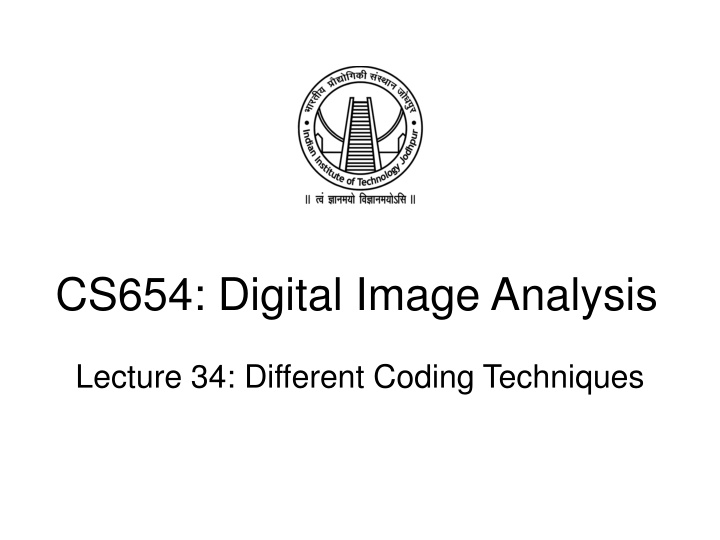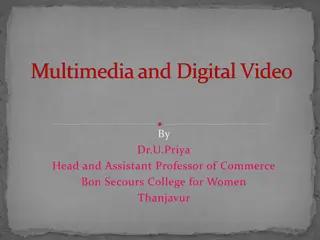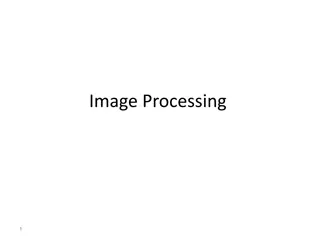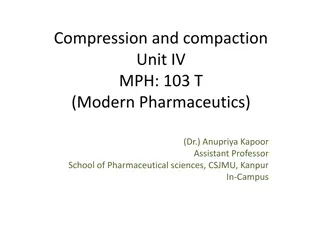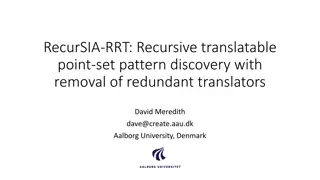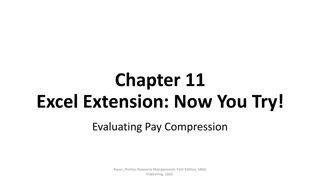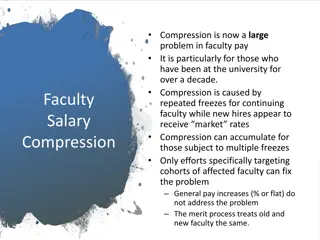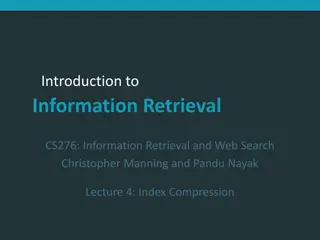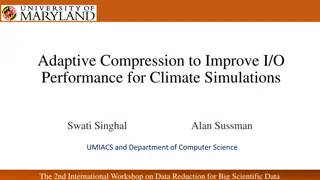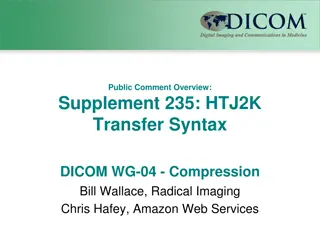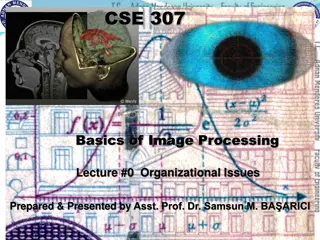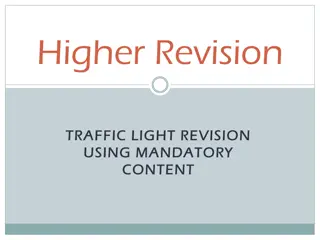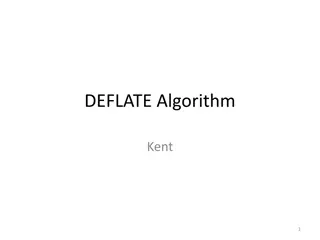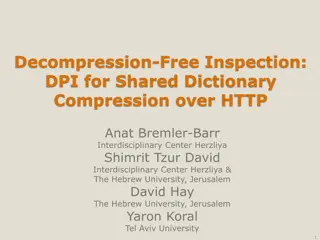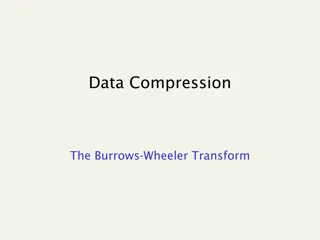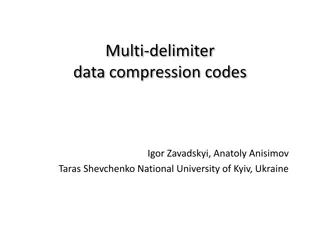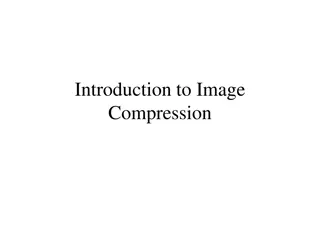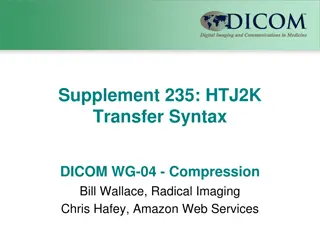Lossless Compression Techniques in Digital Image Analysis
Explore various coding techniques used for lossless compression in digital image analysis, including RLE, Huffman coding, arithmetic coding, LZW, and DPCM. Learn about run-length encoding, 2D RLE, and how DPCM encodes changes between consecutive samples to achieve compression while preserving image quality.
Download Presentation

Please find below an Image/Link to download the presentation.
The content on the website is provided AS IS for your information and personal use only. It may not be sold, licensed, or shared on other websites without obtaining consent from the author.If you encounter any issues during the download, it is possible that the publisher has removed the file from their server.
You are allowed to download the files provided on this website for personal or commercial use, subject to the condition that they are used lawfully. All files are the property of their respective owners.
The content on the website is provided AS IS for your information and personal use only. It may not be sold, licensed, or shared on other websites without obtaining consent from the author.
E N D
Presentation Transcript
CS654: Digital Image Analysis Lecture 34: Different Coding Techniques
Recap of Lecture 33 Morphological Algorithms Introduction to Image Compression Data, Information Measure of Information Lossless and Lossy encryption
Outline of Lecture 34 Lossless Compression Different Coding Techniques RLE Huffman Arithmatic LZW
Lossless Compression Types of coding Repetitive Sequence Encoding Statistical Encoding Predictive Coding Bitplane coding RLE Huffman Arithmatic LZW DPCM
Run length Encoder - Algorithm Start on the first element of input Examine next value If same as previous value Keep a counter of consecutive values Keep examining the next value until a different value or end of input then output the value followed by the counter. Repeat If not same as previous value Output the previous value followed by 1 (run length). Repeat
Run-length coding (RLC) (inter-pixel redundancy) Used to reduce the size of a repeating string of symbols (i.e., runs): 1 1 1 1 1 0 0 0 0 0 0 1 (1,5) (0, 6) (1, 1) Encodes a run of symbols into two bytes: (symbol, count) Can compress any type of data but cannot achieve high compression ratios compared to other compression methods.
Differential Pulse Code Modulation (DPCM) Encode the changes between consecutive samples Example ) (n f (n ) f n n = f = , 0 , 1 1 , 0 , 1 ( ) 156 157 , 158 , 158 , 156 , 156 , 154 , 154 , 155 , f n ( ) 156 , 0 , 1 , 1 , n The value of the differences between samples are much smaller than those of the original samples. Less bits are used to encode the signal (e.g. 7 bits instead of 8 bits)
DPCM Error Input Entropy encoder - Predictor Channel Error Output Entropy decoder + Predictor 92 94 91 97
DPCM Example Differential Pulse Code Modulation (DPCM) Example: A A A B B C D D D D A 0 0 1 1 2 3 3 3 3 change reference symbol if delta becomes too large works better than RLE for many digital images (1.5-to-1)
Huffman Coding (coding redundancy) A variable-length coding technique. Symbols are encoded one at a time! There is a one-to-one correspondence between source symbols and code words Optimal code (i.e., minimizes code word length per source symbol).
Huffman Code Approach Variable length encoding of symbols Exploit statistical frequency of symbols Efficient when symbol probabilities vary widely Principle Use fewer bits to represent frequent symbols Use more bits to represent infrequent symbols A A B A A A B A
Huffman Code Example Symbol Frequency A B C D 13% 25% 50% 12% Original Encoding 00 01 10 11 2 bits 2 bits 2 bits 2 bits Huffman Encoding 110 10 0 111 3 bits 2 bits 1 bit 3 bits Expected size Original 1/8 2 + 1/4 2 + 1/2 2 + 1/8 2 = 2 bits / symbol Huffman 1/8 3 + 1/4 2 + 1/2 1 + 1/8 3 = 1.75 bits / symbol
Huffman Code Data Structures A D Binary (Huffman) tree Represents Huffman code Edge code (0 or 1) Leaf symbol Path to leaf encoding Example A = 110 , B = 10 , C = 0 B 1 0 C 1 0 Priority queue To efficiently build binary tree 0 1
Huffman Code Algorithm Overview Encoding 1. Calculate frequency of symbols in file 2. Create binary tree representing best encoding 3. Use binary tree to encode compressed file 1. For each symbol, output path from root to leaf 2. Size of encoding = length of path 4. Save binary tree
Huffman Code Creating Tree Place each symbol in leaf Weight of leaf = symbol frequency Select two trees L and R (initially leafs) Such that L, R have lowest frequencies in tree Create new (internal) node Left child L Right child R New frequency frequency( L ) + frequency( R ) Repeat until all nodes merged into one tree
Huffman Tree Construction 1 A C E H I 3 5 8 2 7
Huffman Tree Construction 2 A H C E I 3 2 5 8 7 5
Huffman Tree Construction 3 E I A H 8 7 3 2 C 5 5 10
Huffman Tree Construction 4 E I A H 8 7 3 2 C 15 5 5 10
Huffman Tree Construction 5 A H E I = 00 C = 10 A = 111 H = 110 = 01 3 2 C E I 1 0 5 8 7 5 0 1 0 1 15 10 0 1 25
Huffman Coding Example Huffman code E I = 00 C = 10 A = 111 H = 110 = 01 Input ACE Output (111)(10)(01) = 1111001
Huffman Code Algorithm Overview Decoding Read compressed file & binary tree Use binary tree to decode file Follow path from root to leaf
Huffman Decoding 1 A H 1111001 3 2 C E I 1 0 5 8 7 5 0 1 0 1 15 10 0 1 25
Huffman Decoding 2 A H 1111001 3 2 C E I 1 0 5 8 7 5 0 1 0 1 15 10 0 1 25
Huffman Decoding 3 A H 1111001 3 2 C E I 1 0 5 8 7 A 5 0 1 0 1 15 10 0 1 25
Huffman Decoding 4 A H 1111001 3 2 C E I 1 0 5 8 7 A 5 0 1 0 1 15 10 0 1 25
Huffman Decoding 5 A H 1111001 3 2 C E I 1 0 5 8 7 AC 5 0 1 0 1 15 10 0 1 25
Huffman Decoding 6 A H 1111001 3 2 C E I 1 0 5 8 7 AC 5 0 1 0 1 15 10 0 1 25
Huffman Decoding 7 A H 1111001 3 2 C E I 1 0 5 8 7 ACE 5 0 1 0 1 15 10 0 1 25
Limitation of Huffman Code The average code-word length for Huffman coding ? ? ????< ? ? + ????+ ? ?(?) is the entropy of the source alphabet ????is the maximum occurrence of probability in the source alphabet Integer number of bits for encoding purpose
Arithmetic (or Range) Coding Instead of encoding source symbols one at a time, sequences of source symbols are encoded together. There is no one-to-one correspondence between source symbols and code words. Slower than Huffman coding but typically achieves better compression.
Arithmetic Coding (contd) A sequence of source symbols is assigned to a sub-interval in [0,1) which corresponds to an arithmetic code, e.g., arithmetic code 1 2 3 3 4 0.068 [0.06752, 0.0688) Start with the interval [0, 1) As the number of symbols in the message increases, the interval used to represent the message becomes smaller.
Arithmatic Coding We need a way to assign a code word to a particular sequence w/o having to generate codes for all possible sequences Huffman requires keeping track of code words for all possible blocks Each possible sequence gets mapped to a unique number in [0,1) The mapping depends on the prob. of the symbols
Arithmatic Coding Example Symbols 1 Probabilities 0.2 0.2 0.4 0.2 1.0 0.2 0.08 0.0688 0.072 4 0.06752 2 3 4 0.8 0.16 3 0.4 0.08 Encode message: 1 2 3 3 4 2 0.2 0.04 1 [0.06752, 0.0688) or 0.068 (must be inside interval) 0.0 0.0 0.056 0.04 0.0644
Decoding 1.0 0.8 0.72 0.592 0.5728 4 0.5856 0.57152 0.8 0.72 0.688 Decode 0.572 3 0.5728 0.56896 0.4 0.56 0.624 2 3 3 1 2 4 0.2 0.48 0.592 0.5664 0.56768 1 0.0 0.4 0.56 0.56 0.5664
Arithmetic Encoding: Expression Formula for dividing the interval ? ? = ? ? 1 + ? ? 1 ??(?? 1) ? ? = ? ? 1 + ? ? 1 ??(??) ? ??= Cumulative density function ??= ?(? = ?) ?=1 ??? =1 2(? ? + ? ? )
Arithmetic Decoding: Expression 1. Initial value ? 0 = 0 ? 0 = 0 ??? ?(? 1) ? ? 1 ?(? 1) 2. Calculate ? = ???? ? ? < ??(??) 3. Find ??, such that 4. Update limits 5. Repeat until entire sequence is decoded
